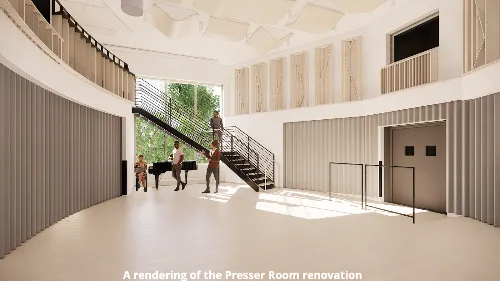Lang Music Building Renovation

The Lang Music Building may be the most unusual and architecturally unique building on Swarthmore’s campus, notorious for a large, open lobby and staggered floor levels. Although a special place to many, its outdated features and need for renovation over the years have led to a $9 million revamp, primarily funded by the Lang Family Foundation.
Originally scheduled to begin April 1, the renovations were postponed due to Covid-19 but soon picked up on May 18. Since then they have been underway, continuing through the summer and the Fall 2020 semester. While many components are complete, the larger renovations will extend until the beginning of December.
According to Susan Smythe, ADA Program Coordinator and project manager for the renovation, “The goal was to completely replace the mechanical system––so, the heating, ventilation, and air conditioning––because they were original to the building from 1973 and were not functioning well both from a comfort standpoint, and then, almost more importantly, for maintenance of all the various instruments that live in the building.” This control of temperature and humidity will not only keep instruments in better condition and tune, but also ameliorate the comfort levels in Lang Concert Hall. Now, the room will be divided into zones to separately regulate the performers’ and audience’s respective temperatures. In addition to the HVAC system enhancements, an exterior egress path has been created, the bathrooms have been renovated, and the roof has been replaced to eliminate leaks.
Another significant change is improvement of the building’s accessibility, which was encouraged by Swarthmore Board of Managers member, Jane Lang. Specifically, a ramp will be added from the lower lobby to the Concert Hall level, providing those in wheelchairs with an alternative to the chairlift. Senior Lecturer of Music, Professor Andrew Hauze ’04 believes this to be one of the most important renovations. “...Accessibility is enormous. Both the ways of getting into the building and navigating the building have been...pretty inaccessible up until now. It’s just amazing to think that in 1973...they really weren’t thinking at all about accessibility of the building. It looks really cool, but it’s really hard to navigate if you have any kind of mobility problem. So I think this renovation is going to go a very, very long way toward making our building available to everybody….”
This isn’t the only change Professor Hauze is excited about. As a Swarthmore graduate himself, he spent the vast majority of his time in the Lang Music Building and now looks forward to living out what he had dreamed of as a student: playing the organ in Lang Concert Hall. “My two main instruments are piano and organ, and when I came to Swarthmore, I was very excited because I had seen pictures of this organ and I thought, ‘this is going to be amazing.’ Unfortunately, I soon discovered that it was not only in bad repair, but there were quirks about its original design that made it somewhat difficult to play. That, plus problems with maintenance over the years, resulted in an instrument which really was not conducive to a student learning on...I’m so thrilled that, really for the first time in a long time, that organ is going to be not only playable, but sounding better than ever...I am so excited to get in there and play it, and to be able to start having events not only involving the organ in concerts...but also [events] like silent movies with organ accompaniment.”
The final, and most extensive, renovation involves the underused Presser Room, which will be completely transformed. Once a windowless, steeply tiered choral rehearsal room, the Presser Room will soon become an entirely flat space––maintaining its mezzanine entrance––with a large window facing Crum Woods. This will be a rehearsal room primarily for Gamelan and Chinese Music Ensemble with storage for their respective instruments; however, installments of acoustic wood ceiling panels will make the room acoustically adjustable for other styles of music, as well.
Faculty, students, and staff alike eagerly wait for these renovations to be finalized, foreseeing many benefits to the Swarthmore community. “In terms of our educational mission, we’re going to be able to offer events using the organ, [and] also offer our students a space in the Presser Room that’s...going to open up a lot of possibilities for collaboration. [The ensembles] have been sort of crammed into various spaces…[but] I think it’s going to make it more attractive to participate in them,” Professor Hauze said. Similarly, Smythe anticipates “exciting options for the Chorus, Orchestra, and other kinds of performances, [and] potential composition opportunities for students.” She believes these renovations will “revitalize a building that is of real architectural significance on campus.”



